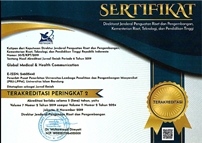The Relationship between Child Abuse and the Risk of Suicidal Ideation among Adolescents in Bandung City
Abstract
Keywords
Full Text:
PDFReferences
Undang-Undang Republik Indonesia Nomor 23 Tahun 2002 tentang Perlindungan Anak.
Pusat Data dan Informasi Kementerian Kesehatan Republik Indonesia. Kekerasan terhadap anak dan remaja. Jakarta: Kementerian Kesehatan Republik Indonesia; 2018.
World Health Organization. Adolescent development [Internet]. Geneva: World Health Organization; 2019 [cited 2019 Aug 12]. Available from: https://www.who.int/maternal_child_ adolescent/topics/adolescence/development/en.
Undang-Undang Nomor 35 Tahun 2014 adalah perubahan atas Undang-Undang Nomor 23 Tahun 2002 tentang Perlindungan Anak.
Jud A, Fegert JM, Finkelhor D. On the incidence and prevalence of child maltreatment: a research agenda. Child Adolesc Psychiatry Ment Health. 2016;10:17.
World Health Organization. Child maltreatment [Internet]. 2016 [cited 2024 Aug 12]. Available from: https://www.who.int/news-room/fact-sheets/detail/child-maltreatment.
Hillis S, Mercy J, Amobi A, Kress H. Global prevalence of past-year violence against children: a systematic review and minimum estimates. Pediatrics. 2016;137(3):e20154079.
United Nations Children's Fund Indonesia. UNICEF and Government of Indonesia launch pelindung anak anti-violence campaign [Internet]. Jakarta: United Nations Children's Fund Indonesia; 2015 [cited 2024 Jul 12]. Available from: https://unicefindonesia.blogspot.com/2015/08/unicef-and-government-of-indonesia.html.
Kementerian Pemberdayaan Perempuan dan Perlindungan Anak, Badan Pusat Statistik. Statistik gender tematik: mengakhiri kekerasan terhadap perempuan dan anak di Indonesia. Jakarta: Kementerian Pemberdayaan Perempuan dan Perlindungan Anak; 2017.
Komisi Perlindungan Anak Indonesia. Data kasus perlindungan anak berdasarkan lokasi pengaduan dan pemantauan media se-Indonesia tahun 2011–2016 [Internet]. Jakarta: Komisi Perlindungan Anak Indonesia; 2016 [cited 2024 Aug 12]. Available from: https://bankdata.kpai.go.id/tabulasi-data/data-kasus-se-indonesia.
Hinds TS, Giardino AP. Child physical abuse: current evidence, clinical practice, and policy directions. New York: Springer; 2020.
Nock MK, Goldblatt MJ. The Oxford handbook of suicide and self-injury. New York: Oxford University Press; 2014.
King CA, Foster CE, Rogalski KM. Teen suicide risk: a practitioner guide to screening, assessment, and management. New York: Guilford Press; 2013.
Soper CA. The evolution of suicide. Cham: Springer; 2017.
Dhamayanti M, Rachmawati AD, Arisanti N, Setiawati EP, Rusmi VK, Sekarwana N. Validitas dan reliabilitas kuesioner skrining kekerasan terhadap anak “ICAST-C” versi bahasa Indonesia. J Keperawatan Padjadjaran. 2017;5(3):281–9.
Yusuf NR. Deteksi dini faktor risiko ide bunuh diri remaja di sekolah lanjutan tingkat atas/sederajat di DKI Jakarta [dissertation]. Depok: Universitas Indonesia; 2019.
Martin MS, Dykxhoorn J, Afifi TO, Colman I. Child abuse and the prevalence of suicide attempts among those reporting suicide ideation. Soc Psychiatry Psychiatr Epidemiol. 2016;51(11):1477–84.
Zatti C, Rosa V, Barros A, Valdivia L, Calegaro VC, Freitas LH, et al. Childhood trauma and suicide attempt: a meta-analysis of longitudinal studies from the last decade. Psychiatry Res. 2017;257:353–8.
McCoy ML, Keen SM. Child abuse and neglect. 3rd Edition. New York: Routledge; 2022.
de Araújo RM, Lara DR. More than words: the association of childhood emotional abuse and suicidal behavior. Eur Psychiatry. 2016;37:14–21.
Kwok SYCL, Gu M, Cheung A. A longitudinal study on the relationship among childhood emotional abuse, gratitude, and suicidal ideation of Chinese adolescents. Child Abuse Negl. 2019;94:104031.
Hadland SE, Wood E, Dong H, Marshall BD, Kerr T, Montaner JS, et al. Suicide attempts and childhood maltreatment among street youth: a prospective cohort study. Pediatrics. 2015;136(3):440–9.
Kwok SYCL, Gu M. Childhood neglect and adolescent suicidal ideation: a moderated mediation model of hope and depression. Prev Sci. 2019;20(5):632–42.
McKenna IE, Gillen A. Direct and indirect effects of maltreatment typologies on suicidality in a representative Northern Irish sample: psychopathology only partially mediates the relationship. J Psychiatr Res. 2016;72:82–90.
Wong WHS, Kuo WH, Sobolewski C, Bhatia I, Ip P. The association between child abuse and attempted suicide. Crisis. 2020;41(3):196–204.
DOI: https://doi.org/10.29313/gmhc.v13i1.14127
pISSN 2301-9123 | eISSN 2460-5441
Visitor since 19 October 2016:
Global Medical and Health Communication is licensed under a Creative Commons Attribution-NonCommercial-ShareAlike 4.0 International License.






























.png)
_(1).png)
_(1).jpg)
